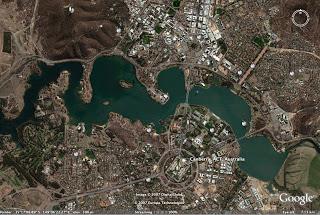
Deleuze's theory (metaphor?) of assemblage as a way of thinking about the social world is an intriguing one. Fundamentally the idea is that there does not exist a fixed and stable ontology for the social world that proceeds from "atoms" to "molecules" to "materials". Rather, social formations are assemblages of other complex configurations, and they in turn play roles in other, more extended configurations.
What is appealing to me about this way of talking about the social world is that it takes us away from the presuppositions we often bring about the social world as consisting of a range of discrete social objects or things. According to this static way of thinking, the state is a thing composed of other things; likewise Islam is an extended social thing; likewise Chicago; and so on. The assemblage approach suggests a different set of metaphors for the social world: mosaic, patchwork, heterogeneity, fluidity, transitory configuration. And this seems like a more realistic way of characterizing large extended social formation like states or regulatory agencies.
The downside of this way of talking and thinking about the social world is precisely the indefiniteness and indeterminacy it suggests for the composition relation. This poses a very hard problem for explanation. How are we to explain the properties and behavior of the composite entity if there is so much contingency in its parts and the ways in which they interact? The strategy of aggregative explanation seems to be a non-starter, since it is stipulated that composition is not a strongly rule-governed process. But so do the comparative and generalizing strategies. If the composites are indeed sui generis and unique configurations we can't generalize across instances and can't usefully compare them.
So how can we gain greater clarity? The concept of assemblage is expressed by Gilles Deleuze; but it is obscure. Here is a valuable blog post by Levi Bryant in LarvalSubjects that extracts several of Deleuze's statements about assemblage from an interview. This interview provides some description of the construct in Deleuze's own words. Here is one of Bryant's efforts at clarifying Deleuze's meaning:
Assemblages are composed of heterogeneous elements or objects that enter into relations with one another. These objects are not all of the same type. Thus you have physical objects, happenings, events, and so on, but you also have signs, utterances, and so on. While there are assemblages that are composed entirely of bodies, there are no assemblages composed entirely of signs and utterances.It isn't easy to paraphrase Deleuze's thinking into a more analytical formulation (though Bryant's efforts are helpful). But the language remains metaphorical, suggestive, and elusive, rather than analytical and discursive. For this reason it is difficult to determine whether the concept has value for sociological theory.
The core ideas are spelled out in a somewhat more accessible form in Manuel DeLanda's A New Philosophy of Society: Assemblage Theory and Social Complexity. DeLanda tries to explain "assemblage" by saying what it is not. First, assemblage theory is opposed to essentialism and reification (26ff.). DeLanda emphasizes that Deleuze's concept resists the "organismic" approach to conceptualizing the social, by which he means an approach that looks at the whole as an inextricable combination of interrelated parts. This implies that the parts are implicated in each other; the organismic perspective emphasizes the internal connectedness of a thing. (This has affinity to Bert Ollman's philosophy of internal relations in Alienation: Marx's Conception of Man in a Capitalist Society.) DeLanda distinguishes between "interiority" and "exteriority" in conceptualizing the components of a thing. For assemblage theory, the relations among the parts are contingent, not necessary. And, crucially, parts can be extracted from one whole and inserted into another. "These relations imply, first of all, that a component part of an assemblage may be detached from it and plugged into a different assemblage in which its interactions are different. In other words, the exteriority of relations implies a certain autonomy for the terms they relate" (10-11). Another aspect of the theory, according to DeLanda, is the fact that it does not privilege one level of organization over another. "Micro" is not more fundamental than "macro"; instead, social reality is "multiscaled" (38), with assemblages occurring at every level.
Truthfully, neither Deleuze nor DeLanda succeeds in making the concept of assemblage a very clear or analytically specific one. So let's consider a diluted version of assemblage theory that might nonetheless be useful for sociological theory while foregoing much of the metaphysical language characteristic of Deleuze's writings:
- Social entities are composed of components and lesser systems.
- The components of a social entity are heterogeneous.
- The components include both material factors and meaningful expressions.
- The components have their own characteristics and dynamics.
- The components may have very different temporal and spatial scales.
- The effects and interactions among components may be indeterminate because of complexity effects and probabilistic causal mechanisms.
- The behavior of the whole is difficult or impossible to calculate even given extensive knowledge of the dynamics of the components.
- A city consists of population, businesses, roads, organizations, government policies, political movements, disaffected youth, and slogans.
- Population dynamics have a temporal scale of decades, while businesses have a temporal scale of months.
- The interaction effects of gradual population change, the voting system, and gradual environmental change are difficult to calculate.
- We can nonetheless make efforts to disentangle the effects of population change, institutional design, and environment on things like land use and effective taxation rates.
(Daniel Smith's article on Deleuze in the Stanford Encyclopedia of Philosophy is a readable exposition of Deleuze's philosophy; link. Another useful resource on assemblage theory is Nick Srnicek's masters' thesis; link. )
